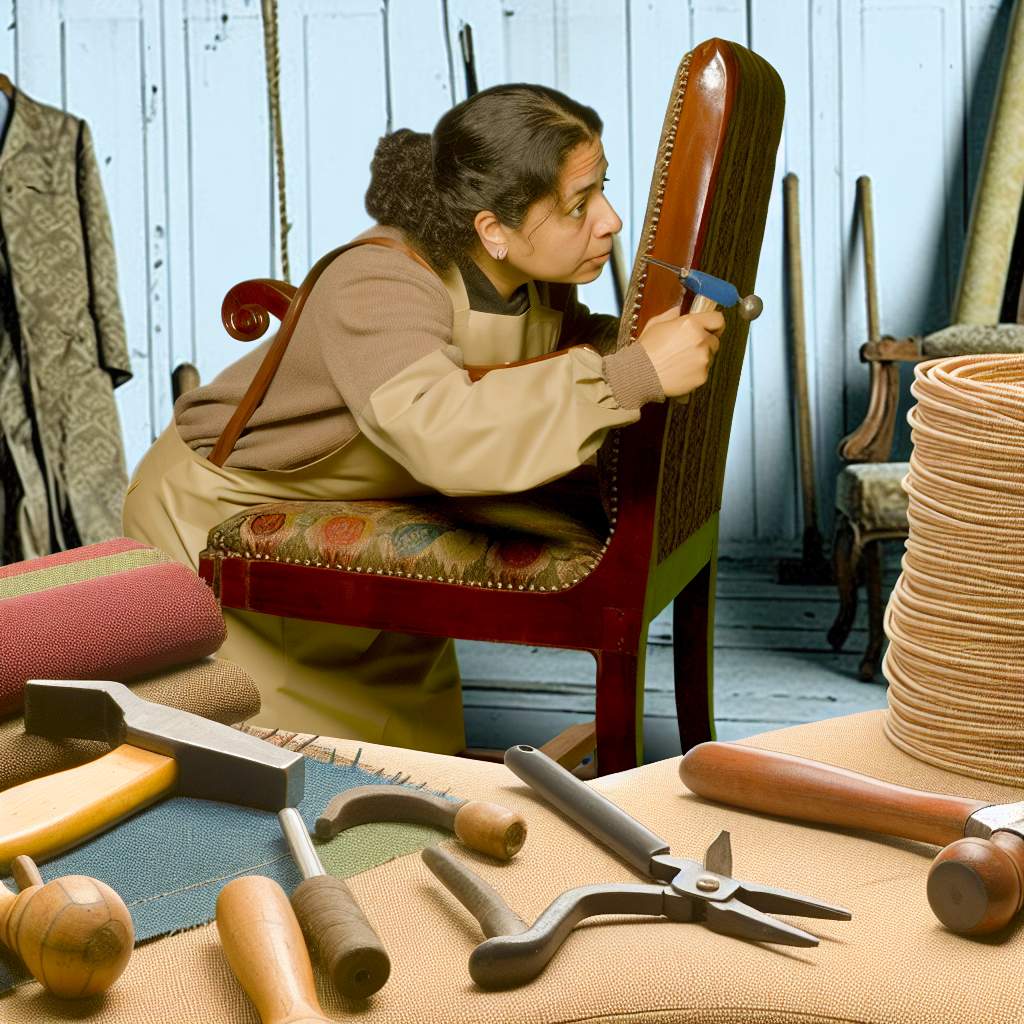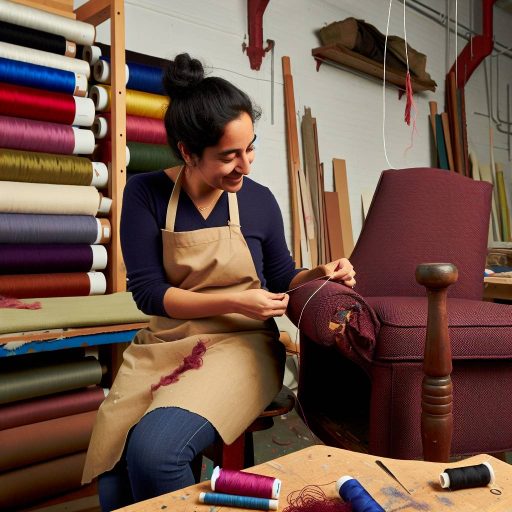Introduction to Upholstery Tools and Their Importance
Upholstery tools play a vital role in crafting and restoring furniture.
These tools help maintain high standards of workmanship.
Using the right tools enhances efficiency and results in better finishes.
Furthermore, having quality tools ensures that the job is done correctly.
Each tool serves a unique purpose, making it essential for upholsterers.
Investing in good tools is crucial for any professional upholsterer.
They allow for precision and creativity throughout every project.
Additionally, knowing how to use each tool properly is equally important.
Besides improving skills, the right tools can also prevent damage to materials.
Ultimately, having a well-equipped toolbox lays the foundation for success.
Basic Hand Tools Every Upholsterer Needs
Essential Cutting Tools
A sharp utility knife is crucial for any upholsterer.
This tool helps in cutting fabric and foam accurately.
Additionally, a pair of scissors specifically for fabric is necessary.
Investing in high-quality pinking shears is also beneficial.
These shears help prevent fraying on the edges of fabrics.
Reliable Fastening Tools
Tack pullers are essential for removing old upholstery.
They help preserve the integrity of the frame during renovation.
A staple gun is another important tool for fastening materials.
These guns come in manual and electric options for versatility.
Measuring and Marking Tools
Always have a measuring tape within reach.
This tool is vital for ensuring accurate measurements of fabrics.
User-friendly chalk pencils assist in marking fabric for cutting.
These markings can easily wash off, leaving no residue.
Supportive Accessories
Upholstery foam is indispensable for comfort and shape.
A variety of upholstery threads in different colors is needed.
Unlock Your Career Potential
Visualize a clear path to success with our tailored Career Consulting service. Personalized insights in just 1-3 days.
Get StartedAlso, keep a collection of needles specific to upholstery work.
This variety ensures you can handle different fabric types.
Lastly, don’t forget a good set of pliers for gripping and pulling.
Cutting Tools: Types and Uses in Upholstery
Overview of Cutting Tools
Cutting tools are essential for any upholsterer.
They ensure precise cuts and high-quality finishes.
Understanding various cutting tools enhances your efficiency.
Types of Cutting Tools
Several types of cutting tools are commonly used in upholstery.
Each tool serves a specific purpose and offers unique advantages.
-
Utility Knife
A utility knife is versatile and easy to use.
It excels at cutting upholstery fabric and foam.
Replaceable blades make it cost-effective for professionals.
-
Scissors
Heavy-duty scissors are fundamental for upholsterers.
Choose scissors designed for thick materials.
They provide precision when cutting intricate designs.
-
Rotary Cutter
A rotary cutter offers speed and accuracy.
It works well on multiple layers of fabric.
This tool requires a cutting mat for safety and effectiveness.
-
Shears
Shears deliver clean cuts with minimal fraying.
They are ideal for heavy-duty fabrics and leather.
Proper maintenance ensures longevity and performance.
Choosing the Right Cutting Tool
Choosing the right tool depends on the project type.
For intricate patterns, scissors and shears are preferable.
Use a utility knife for straight, long cuts.
Rotary cutters work best for larger pieces of fabric.
Maintenance of Cutting Tools
Maintaining your cutting tools is vital for longevity.
Regularly sharpen blades to ensure crisp cuts.
Store them properly to avoid damage or dulling.
Cleaning tools after each use prevents material buildup.
You Might Also Like: How to Build a Successful Bricklaying Business
Fastening Tools: Tackers, Staplers, and Nails
Overview of Fastening Tools
Fastening tools are essential for any upholsterer.
They aid in securing fabrics and components firmly.
Understanding the types of fastening tools increases efficiency.
Tackers
Tackers come in various forms, including manual and electric types.
Manual tackers require physical strength, while electric tackers save time.
Popular brands like Arrow and Stanley offer reliable options.
Choose a tacker based on your project needs.
Always ensure you have the right size staples for your tacker.
Staplers
Staplers are versatile and easy to use.
They provide strong adhesion for different upholstery materials.
Pneumatic staplers can speed up the process significantly.
Consider models from brands like Bostitch or DeWalt.
Always maintain your stapler for optimal performance.
Nails
Nails come in various types, such as finishing and upholstery nails.
Upholstery nails add decorative touches to your projects.
Choose high-quality nails to prevent rusting and bending.
Keep a variety of sizes in your toolbox for flexibility.
Properly drive nails using a suitable hammer or machine.
Choosing the Right Tool
Select the correct fastening tool based on your material.
Consider the thickness and type of fabrics you are using.
For heavy-duty projects, pneumatic options are ideal.
For finer work, manual tools may be more manageable.
Safety Precautions
Always prioritize safety when using fastening tools.
Wear eye protection to guard against flying staples.
Keep your workspace organized to avoid accidents.
Store tools properly to prevent damage and injury.
Regularly inspect tools for wear and replace them as needed.
Uncover the Details: Common Challenges Faced by Canadian Bricklayers
Measuring and Marking Tools: Ensuring Precision in Upholstery
Accuracy is crucial in upholstery work.
Precise measurements guarantee a perfect fit for each piece.
Inaccurate measurements can lead to wasted materials and time.
Essential Measuring Tools
Start with a reliable tape measure.
This tool allows for easy measurement of fabric and furniture dimensions.
Use a straight ruler for more precise measurements on flat surfaces.
A carpenter’s square helps in achieving right angles on corners.
Marking Tools for Clarity
Fabric markers make clear, visible lines for cutting.
Use chalk pencils for temporary markings that can be erased easily.
Tailor’s chalk offers a traditional option for marking fabrics.
Advanced Measurement Aids
Digital measuring tools can enhance precision.
Laser measuring devices provide accurate measurements with minimal effort.
Consider a caliper for detailed measurements of smaller sections.
Maintaining Your Tools
Keep your measuring tools clean and dry.
Regularly check for accuracy to ensure effective use.
Store tools in a dedicated toolbox to prevent damage.
Uncover the Details: Importance of Blueprint Reading in Metal Fabrication

Sewing Tools
Needles
Needles play a crucial role in upholstery sewing.
Different types of needles serve various fabric needs.
It’s important to choose the right needle for the task.
For heavy fabrics, use a strong, thick needle.
A ballpoint needle works best for knit fabrics.
Always keep a variety of needle sizes in your toolbox.
Threads
Quality thread is essential for lasting upholstery.
Choose durable, high-tensile strength threads for best results.
Polyester threads are popular due to their strength and versatility.
Consider using cotton thread for a more traditional look.
Keep an assortment of colors to match different projects.
Store threads properly to prevent tangling and fraying.
Sewing Machines
A reliable sewing machine is fundamental for upholstery projects.
Look for machines that can handle thick fabrics effortlessly.
Heavy-duty sewing machines offer more power and stability.
Consider a walking foot attachment for even feeding of materials.
Regular maintenance ensures optimal performance.
Invest in a machine with multiple stitch options for versatility.
Uncover the Details: Exploring Sustainable Practices in Bricklaying
Padding and Layering Tools: Adding Comfort and Style
Importance of Padding
Padding enhances the comfort of upholstered furniture.
It protects frames and provides support for users.
Choosing the right padding material is essential for quality.
Different projects may require different types of padding.
Types of Padding
Polyester fiberfill is popular for its softness and resilience.
Foam padding offers excellent support but varies in density.
Natural materials, like cotton or wool, provide eco-friendly options.
Each type contributes unique characteristics to your upholstery work.
Layering for Style and Functionality
Layering materials improves both comfort and aesthetics.
For instance, combining foam with padding creates a plush feel.
Different textures can also add visual interest to furniture.
Carefully consider your layer choices for optimal outcomes.
Essential Layering Tools
A foam cutter easily shapes your padding materials.
Padding shears allow for precise cuts on various fabrics.
Adhesive sprays secure layers together effectively.
By using the right tools, you can achieve professional results.
Maintenance and Care of Upholstery Tools for Longevity
Regular Cleaning Practices
Begin by cleaning your upholstery tools after each use.
Use a damp cloth to wipe off dust and debris.
For metal tools, apply a light coat of oil to prevent rust.
This step ensures they remain effective and safe.
Proper Storage Techniques
Store tools in a dedicated toolbox or storage area.
Keep them organized and separated to avoid damage.
Avoid exposure to moisture to prevent corrosion.
Label compartments for easy identification.
Routine Inspections
Inspect your tools regularly for wear and tear.
Check wooden handles for splinters or cracks.
Look for any loose components on mechanical tools.
Address issues immediately to prolong their lifespan.
Safe Usage Guidelines
Always follow manufacturer instructions during use.
Use the right tool for each job to avoid misuse.
Wear safety gear to protect yourself while working.
Proper handling prevents damage to both tools and upholstery.
Professional Maintenance Services
Consider professional cleaning for complex tools.
Seek expert advice for repair options when needed.
Regular professional check-ups can enhance tool longevity.
This investment pays off in terms of performance.




